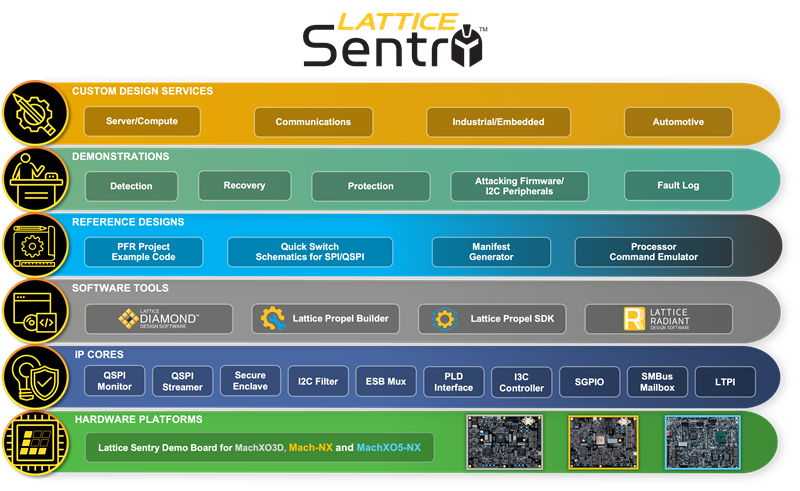Photo Gallery
 |
Lattice Sentry™ solution stack

Additional Info
| Company | Lattice Semiconductor |
| Company size | 1,000 - 4,999 employees |
| World Region | North America |
| Website | https://www.latticesemi.com/ |
NOMINATION HIGHLIGHTS
In today’s rapidly evolving digital landscape, the importance of cyber resilience cannot be overstated. The rise of modern technology – including automation, machine learning (ML), 5G, and artificial intelligence (AI) – has provided us with a host of benefits and advancements, but it has also opened doors for increased vulnerability to cyberattacks. Most of today’s security solutions often do not have the real-time protection required to manage multiple devices if an attack does occur. The Lattice Sentry™ solution stack can help minimize in-system firmware attack vulnerabilities by providing real-time, dynamic protection, detection, and recovery capabilities to programmable components in a system.
Lattice Sentry provides customers with a complete reference platform, fully validated IP building blocks, easy-to-use FPGA design tools, reference design/demonstrations, and a network of custom design services compliant with National Institute of Standards and Technology (NIST) Platform Firmware Resiliency (PFR) Guidelines. Together, these form a comprehensive set of tools to help system developers more easily design with security in mind and get to market quickly. This includes a suite of ready-to-use, cyber resilient, production-validated IP cores to protect and monitor SPI and I2C devices and their buses within a system, as well as demo boards and reference designs to test and showcase PFR capabilities. The Lattice Sentry solution stack is supported by the Lattice Propel™ software design tool, which helps users who are unfamiliar with FPGA languages customize their PFR implementations, enabling them to modify the C code for the stack’s RISC-V processor IP and visually lay out the IP used to create a complete system, drastically reducing time to market.
Key Capabilities / Features
The Lattice Sentry solution stack provides everything system designers need to evaluate, develop, test, and deploy a NIST SP800-193-compliant, FPGA-based PFR RoT. It includes a complete reference platform, validated IP building blocks, FPGA design tools, reference designs, and a network of custom design services. This comprehensive set of tools helps developers design with security in mind and get to market quickly. The stack features ready-to-use, cyber resilient, production-validated IP cores to protect and monitor SPI and I2C devices and their buses. It also includes demo boards and reference designs to test and showcase PFR capabilities. Supported by the Lattice Propel™ software design tool, users can customize their PFR implementations, modify C code for the stack’s RISC-V processor IP, and visually lay out the IP to create a complete system, reducing time to market.
Lattice Sentry focuses on enhanced security for servers and datacenters, addressing the evolving security requirements of current and emerging server platforms. It supports 384-bit encryption and enables next-generation hardware Root of Trust (HRoT) solutions. The stack supports firmware security across various markets, including Communications, Computing, Industrial, Automotive, and Consumer. Integrated solutions support ECDSA (40 ms), SHA (up to 70 Mbps), and QSPI performance (64 MHz) for faster boot times, minimizing system downtime and reducing exposure to firmware attacks during boot. With demo boards and reference designs, Lattice Sentry offers real-time monitoring of up to five mainboard components at boot and during operation, outperforming MCU-based security solutions.
To help organizations stay secure and keep pace with the evolving security landscape, Lattice is committed to the ongoing improvement of the security, performance, and ease-of-use capabilities of the Sentry solution stack, regularly issuing updates that add new capabilities and features.
How we are different
•Enhanced security – Lattice Sentry supports a secure enclave IP block that enables 384-bit cryptography (ECC-256/384 and HMAC-SHA-384) to better secure Lattice Sentry-protected firmware against unauthorized access. Support for 384-bit crypto is a requirement for many next-generation server platforms.
•4X faster pre-boot authentication – Lattice Sentry supports faster ECDSA (40 ms), SHA (up to 70 Mbps), and QSPI performance (64 MHz), enabling faster boot times that help minimize system down time and reduce exposure to attempted attacks on firmware during the boot process.
•Ability to monitor up to 5 firmware images in real-time – Lattice Sentry enables real-time monitoring of up to five mainboard components in a system at boot and during ongoing operation. Competing MCU-based security solutions, as an example, lack the processing performance to properly monitor that many components in real-time.

Vote by Sharing
- Like
- Digg
- Tumblr
- VKontakte
- Buffer
- Love This
- Odnoklassniki
- Meneame
- Blogger
- Amazon
- Yahoo Mail
- Gmail
- AOL
- Newsvine
- HackerNews
- Evernote
- MySpace
- Mail.ru
- Viadeo
- Line
- Comments
- SMS
- Viber
- Telegram
- Subscribe
- Facebook Messenger
- Kakao
- LiveJournal
- Yammer
- Edgar
- Fintel
- Mix
- Instapaper
- Copy Link
Each completed social share counts as a vote for this award nomination.



